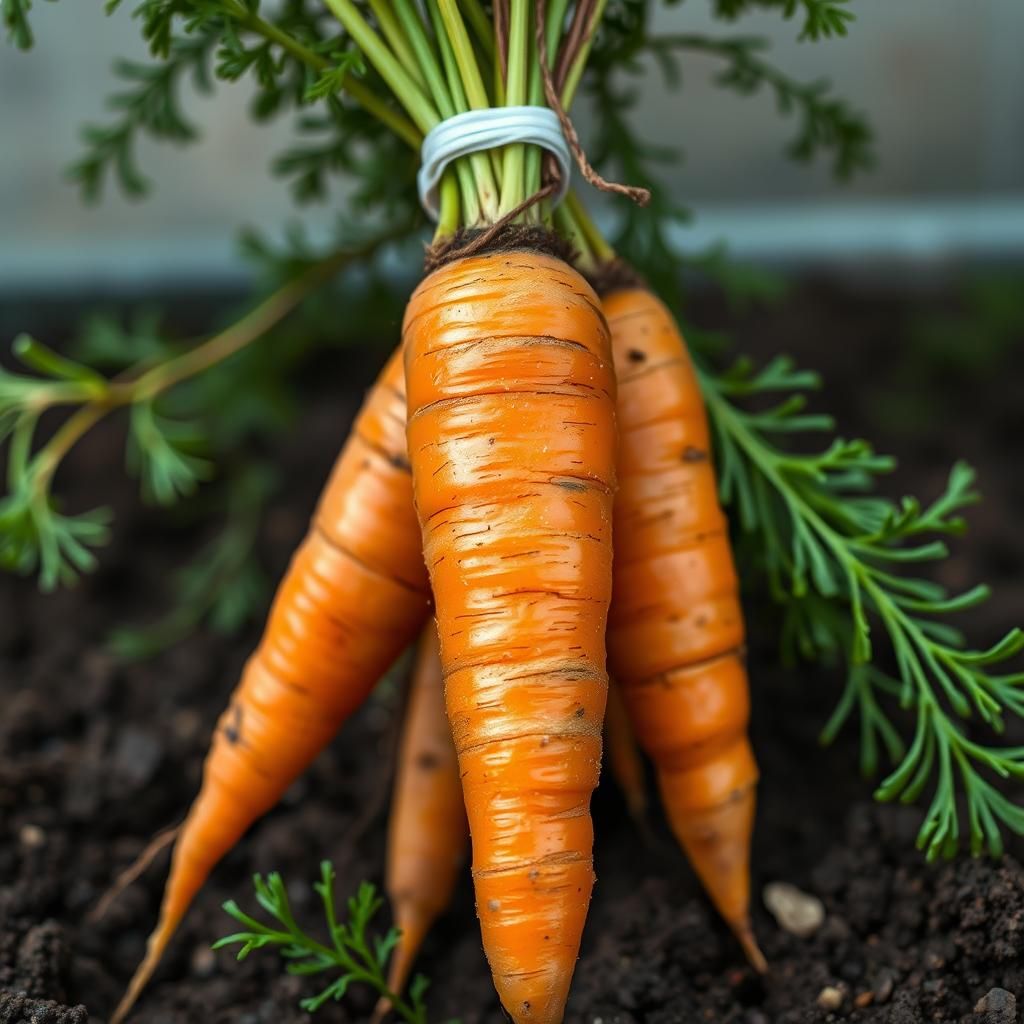Discover How Carrots Grow from Carrot Seeds: A Complete Guide

Carrots are a popular vegetable known for their vibrant color and nutritional benefits. Understanding how carrots grow from seeds can be a fascinating journey, whether you're a seasoned gardener or a curious novice. This complete guide will take you through the entire process, from selecting the right seeds to planting, nurturing, and harvesting your crop. We’ll explore the ideal growing conditions, care tips, and common challenges you might face along the way. Dive in to discover the intricate journey of carrot seeds transforming into the crunchy, sweet vegetables we all love, and learn how to cultivate your own successful carrot garden.
The Growth Process of Carrots from Carrot Seeds
Carrots grow from carrot seeds, which are tiny, round, and hard. The growth process begins when these seeds are sown into well-drained soil and kept adequately moist. As the seeds absorb water, they germinate, typically within 14 to 21 days, especially if the soil temperature is between 55°F and 75°F. Once germination occurs, the seedlings emerge and begin to photosynthesize, developing their characteristic feathery leaves. Over the course of several weeks to months, the root develops beneath the soil, thickening to form the edible carrot that we are familiar with. This entire process requires careful attention to soil quality, light exposure, and watering practices to ensure healthy growth and ultimately a successful harvest.
Understanding Carrot Seeds
Carrot seeds are small and can be somewhat challenging to handle due to their size. They are actually the fruit of the plant and contain on average 2 to 3 seeds per fruit. When preparing to plant carrots, it is essential to choose high-quality seeds from reputable sources to ensure the best potential for growth. Additionally, carrot seeds have a short shelf-life, so they should be used within a year or two of purchase for optimal germination rates.
Soil Requirements for Carrot Growth
Carrots prefer loamy, well-drained soil that is rich in organic matter. The soil should ideally be free of rocks and hard clumps to allow for the straight and uninterrupted growth of the carrot roots. It's crucial to test the pH level of the soil, as carrots thrive in a pH range of 6.0 to 6.8. Amending the soil with compost can enhance its fertility and structure, providing the right environment for seeds to germinate and grow into robust plants.
Watering and Care for Carrots
Consistent watering is vital for the healthy growth of carrot plants. Carrots require around 1 inch of water per week, which may increase in hotter climates. It's important to water deeply and less frequently rather than shallowly and daily, as this encourages the roots to grow deeper into the soil. Mulching around the plants can help retain moisture and suppress weed growth, which is beneficial during the crucial growing phase.
See also:
Pest and Disease Management
Carrots can be vulnerable to various pests and diseases, which can hinder their growth. Common pests include the carrot fly, which lays eggs near the roots, and aphids, which can damage the plant and transmit diseases. Implementing companion planting techniques, using row covers, and practicing crop rotation can greatly reduce pest pressures. Additionally, keeping the garden clean and removing any debris can help prevent the spread of diseases that affect carrots.
Harvesting Carrots
Timing is essential when it comes to harvesting carrots; they are typically ready for harvest 70 to 80 days after sowing, depending on the variety. The ideal size for harvesting is when the shoulders of the carrots are about 1/2 to 1 inch in diameter. To harvest, carefully loosen the soil around the carrots with a fork to prevent breaking the roots. After lifting them from the ground, it’s recommended to remove the green tops immediately to prevent the roots from becoming woody and tough.
| Aspect | Details |
|---|---|
| Seed Size | Small, round seeds |
| Soil Preference | Loamy, well-drained soil |
| Watering Needs | 1 inch of water per week |
| Pest Concerns | Carrot fly, aphids |
| Harvest Size | 1/2 to 1 inch diameter |
Understanding the Life Cycle of Carrots from Seed to Harvest
Carrots begin their life cycle as tiny seeds that are sown into the soil. These seeds contain essential stored nutrients, which provide the energy needed for germination. Within a week or two, these seeds sprout, developing small green shoots that break through the soil surface. As the plants mature, they absorb nutrients and water from the soil, while the roots gradually swell and transform into the nutritious tubers we recognize as carrots. Conditions such as temperature, sunlight, and soil quality play a crucial role in this process, allowing carrots to reach their full potential in growth and flavor.
Choosing the Right Carrot Seeds
Selecting the appropriate carrot seeds is vital for a successful harvest. Different varieties of carrots, such as Nantes, Danvers, or Imperator, vary in terms of flavor, color, and growing habits. Beginners should consider factors like local climate, the length of the growing season, and their preferences for crunchiness and sweetness when choosing seeds. Additionally, it's essential to acquire seeds from a reputable supplier to guarantee their viability and germination rate.
Preparing the Soil for Carrot Planting
Soil preparation is crucial for fostering healthy carrot growth. Carrots thrive in loamy, well-drained soil rich in organic matter to promote root development. Prior to planting, it's beneficial to loosen the soil to a depth of at least 12 inches to allow the roots to grow freely. Adding compost or well-rotted manure can enhance soil fertility, while maintaining a neutral pH (around 6.0 to 7.0) will support optimal growth. Avoiding compacted soil is essential, as it can hinder the root formation and lead to forked or stunted carrots.
See also:
Caring for Carrot Plants During Growth
Once the carrot seeds are sown, providing adequate care throughout their growth is paramount. Regular watering is essential, particularly during dry spells, as carrots need consistent moisture to develop properly. However, overwatering can lead to blistering and rot. Weeding is also important to reduce competition for nutrients and water; using mulch can help retain moisture and suppress weeds. Monitoring the plants for signs of pests or diseases ensures that any issues are addressed promptly, promoting a healthier crop.
Harvesting Carrots at the Right Time
Knowing when to harvest carrots is key to enjoying their optimal flavor and texture. Generally, carrots are ready to pick when they reach a diameter of 1/2 to 1 inch, typically between 60 to 80 days after planting, depending on the variety. The best time for harvesting is usually in the early morning or late afternoon when temperatures are cooler. Gently loosening the soil with a fork helps prevent breakage, and it’s advisable to shake off excess soil rather than washing them immediately, which can lead to spoilage during storage.
Storing and Enjoying Harvested Carrots
Proper storage of harvested carrots can extend their freshness and crispness. Carrots should be kept in a cool, dark place; ideally, moisture should be maintained without allowing them to become overly wet. Refrigeration is one of the best methods for storage, as it helps prolong their shelf life. When ready to use, carrots can be enjoyed in a variety of ways, whether raw in salads, steamed, or roasted, showcasing their natural sweetness and versatility in various dishes.
Questions from Our Readers
Do carrots grow from carrot seeds?
Yes, carrots grow from carrot seeds. When planted in the soil, these seeds germinate and develop into carrot plants, which ultimately produce the edible root vegetables we consume.
How long does it take for carrot seeds to grow?
Typically, it takes about 70 to 80 days for carrot seeds to grow into mature carrots. Factors like soil quality, temperature, and water availability can impact this growth period.
See also:
Can I grow carrots from store-bought carrots?
You cannot grow carrots from store-bought carrots directly, as they are generally harvested for consumption and do not contain viable seeds. However, you can grow new carrots by planting carrot tops in water, but they won't produce a full-sized carrot.
What conditions do carrot seeds need to grow?
Carrot seeds require well-drained soil, full sunlight, and consistent moisture to thrive. The ideal temperature for germination is between 60°F to 65°F (15°C to 18°C), making it essential to plant them in the right season for optimal growth.

If you want to read more articles like Discover How Carrots Grow from Carrot Seeds: A Complete Guide, we recommend you check out our Seeds category.
Leave a Reply
Related Articles